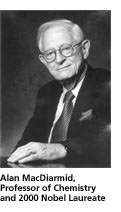
CHEMISTRY NOBEL AGAIN
 For the second year in a row a scientist associated with the School of Arts and Sciences was awarded the Nobel Prize in chemistry. Alan G. MacDiarmid, the Blanchard Professor of Chemistry, was recognized by the Royal Swedish Academy, along with two other scientists, for the discovery and subsequent study of "synthetic metals"--plastics that conduct electricity.
For the second year in a row a scientist associated with the School of Arts and Sciences was awarded the Nobel Prize in chemistry. Alan G. MacDiarmid, the Blanchard Professor of Chemistry, was recognized by the Royal Swedish Academy, along with two other scientists, for the discovery and subsequent study of "synthetic metals"--plastics that conduct electricity.
"We are deeply honored that Alan's outstanding scientific achievements have received such prestigious recognition," declared Dean Sam Preston. "This is a great moment not only for him but for the entire School and University."
Last year SAS alumnus Ahmed Zewail, G'74, Hon'97, of Caltech received the Nobel in chemistry for his pioneering work in femtochemistry, the study of chemical reactions that take place in an instant. Stanley Prusiner, C'64, M'68, another chemistry department graduate, received the 1997 prize for his discovery of the prion.
The ground-breaking research of MacDiarmid and his colleagues opened up the new field of carbon-based electronics. The Nobel committee stated that "[t]he choice is motivated by the important scientific position that the field has achieved and the consequences in terms of practical applications and of interdisciplinary development between chemistry and physics." Alan Heeger, a co-recipient of the prize now at UC Santa Barbara, was a physics professor in SAS for 23 years.
 The revolutionary plastics fabricated by these distinguished chemists and physicists have laid the foundation for 21st century technologies. "For many years I used to say that these materials were answers waiting for the questions to be asked," MacDiarmid commented. The questions are now coming fast. Scientists expect conducting polymers to find applications in lightweight and flexible computer screens, solar panels, cellular phone displays, plastic batteries, inexpensive electronic chips, and more. Medical researchers have reported encouraging success mending severed nerves with a conductive plastic sleeve.
The revolutionary plastics fabricated by these distinguished chemists and physicists have laid the foundation for 21st century technologies. "For many years I used to say that these materials were answers waiting for the questions to be asked," MacDiarmid commented. The questions are now coming fast. Scientists expect conducting polymers to find applications in lightweight and flexible computer screens, solar panels, cellular phone displays, plastic batteries, inexpensive electronic chips, and more. Medical researchers have reported encouraging success mending severed nerves with a conductive plastic sleeve.
"Everybody thinks that their own baby is beautiful," quipped the School's newest Nobel laureate, "and it's very nice to know that someone else thinks your baby is beautiful."